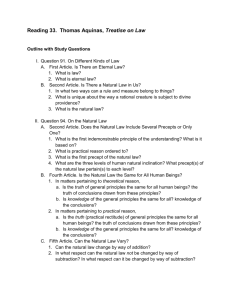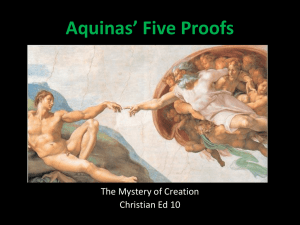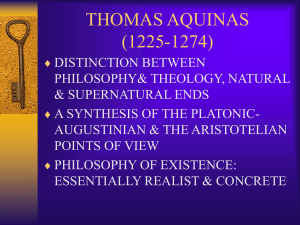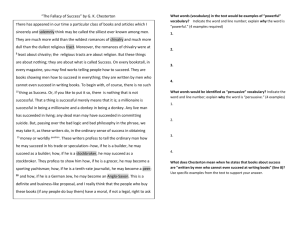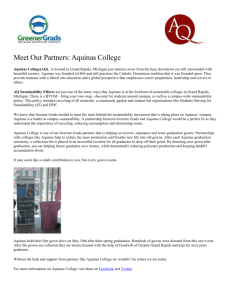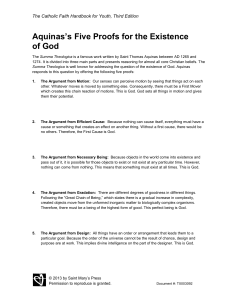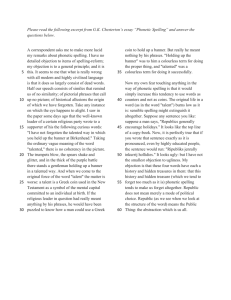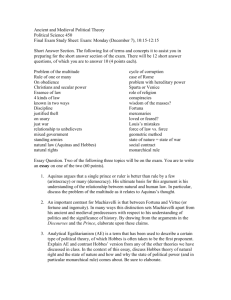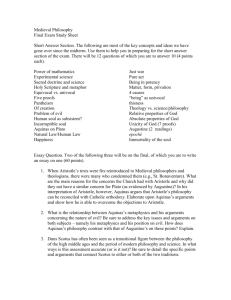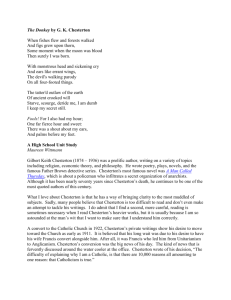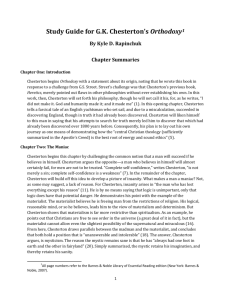The Figure in the Frame Biographical Knowledge in St Thomas
advertisement
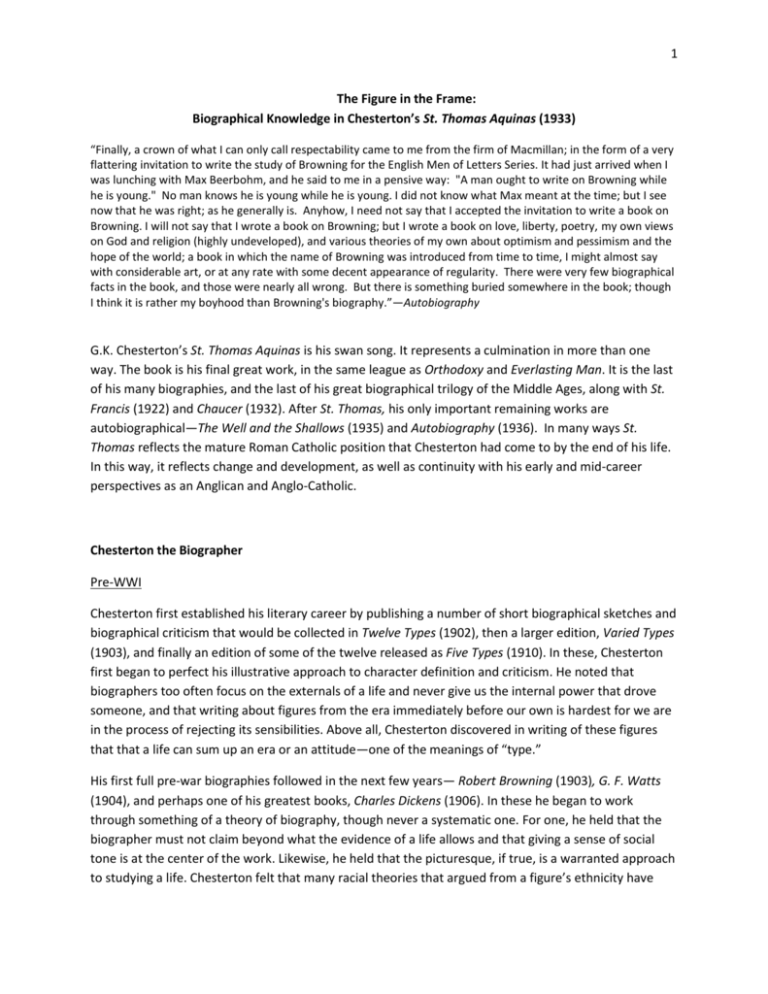
1 The Figure in the Frame: Biographical Knowledge in Chesterton’s St. Thomas Aquinas (1933) “Finally, a crown of what I can only call respectability came to me from the firm of Macmillan; in the form of a very flattering invitation to write the study of Browning for the English Men of Letters Series. It had just arrived when I was lunching with Max Beerbohm, and he said to me in a pensive way: "A man ought to write on Browning while he is young." No man knows he is young while he is young. I did not know what Max meant at the time; but I see now that he was right; as he generally is. Anyhow, I need not say that I accepted the invitation to write a book on Browning. I will not say that I wrote a book on Browning; but I wrote a book on love, liberty, poetry, my own views on God and religion (highly undeveloped), and various theories of my own about optimism and pessimism and the hope of the world; a book in which the name of Browning was introduced from time to time, I might almost say with considerable art, or at any rate with some decent appearance of regularity. There were very few biographical facts in the book, and those were nearly all wrong. But there is something buried somewhere in the book; though I think it is rather my boyhood than Browning's biography.”—Autobiography G.K. Chesterton’s St. Thomas Aquinas is his swan song. It represents a culmination in more than one way. The book is his final great work, in the same league as Orthodoxy and Everlasting Man. It is the last of his many biographies, and the last of his great biographical trilogy of the Middle Ages, along with St. Francis (1922) and Chaucer (1932). After St. Thomas, his only important remaining works are autobiographical—The Well and the Shallows (1935) and Autobiography (1936). In many ways St. Thomas reflects the mature Roman Catholic position that Chesterton had come to by the end of his life. In this way, it reflects change and development, as well as continuity with his early and mid-career perspectives as an Anglican and Anglo-Catholic. Chesterton the Biographer Pre-WWI Chesterton first established his literary career by publishing a number of short biographical sketches and biographical criticism that would be collected in Twelve Types (1902), then a larger edition, Varied Types (1903), and finally an edition of some of the twelve released as Five Types (1910). In these, Chesterton first began to perfect his illustrative approach to character definition and criticism. He noted that biographers too often focus on the externals of a life and never give us the internal power that drove someone, and that writing about figures from the era immediately before our own is hardest for we are in the process of rejecting its sensibilities. Above all, Chesterton discovered in writing of these figures that that a life can sum up an era or an attitude—one of the meanings of “type.” His first full pre-war biographies followed in the next few years— Robert Browning (1903), G. F. Watts (1904), and perhaps one of his greatest books, Charles Dickens (1906). In these he began to work through something of a theory of biography, though never a systematic one. For one, he held that the biographer must not claim beyond what the evidence of a life allows and that giving a sense of social tone is at the center of the work. Likewise, he held that the picturesque, if true, is a warranted approach to studying a life. Chesterton felt that many racial theories that argued from a figure’s ethnicity have 2 distorted the record and blinded the biographer to the evidence, though Chesterton was willing at times to indulge in judgments based on nationality. Moreover, Chesterton began to further explore the challenges of presenting to a modern audience a bygone person and era. Arguably, this first period ended with his 1910 study Blake, though his Appreciations and Criticisms of the Works of Charles Dickens (1911) often work from biographical and historical judgments. Post-WWI Along with the eulogy Lord Kitchener (1917) and the medieval trilogy, Chesterton’s post-war biographies included testaments to two non- or post-Christian heroes, William Cobbett (1925) and Stevenson (1927). Both of these, in a way, functioned as studies of figures who bookended the nineteenth-century and who demonstrated the aftershocks of the Reformation on England and Scotland. While Chesterton’s study of Cobbett expanded on the nineteenth-century pamphleteer whose ideals predated Belloc’s and his own distributism, his book on Robert Louis Stevenson was a work of biographical criticism in the style of his earlier sketches. The medieval trilogy, of course, praises the Middle Ages: St. Francis of Assisi values of poverty, nature, whimsy and poetry, and it uses the motifs of fighter, builder, juggler, poor man, and troubadour to organize the book. It also explores the question of miracles and the standards of historical credulity. Chaucer is an apologetic celebration of Chaucer’s greatness, his contribution to the English language, his trust in the commonplace, his metaphysical joy and light, and above all, his Catholicism. Chaucer becomes for Chesterton a test case as to the complexity and superiority of the medieval period to the Renaissance and to the modern world. St. Thomas Aquinas builds off both of these by advancing a picture of the Middle Ages. Yet it also goes further, for in it, perhaps more than the other two, Chesterton advances not only a philosophy of life, which had been the burden of his entire career, but also his final judgment on the nature of the universe and the human person’s epistemic relationship to it. “But these fixed points of faith and philosophy are things for a theoretical work and have no particular place here. And in the matter of history and biography, which have their place here, nothing is fixed at all. The world is in a welter of the possible and impossible, and nobody knows what will be the next scientific hypothesis to support some ancient superstition. Three-quarters of the miracles attributed to St. Francis would already be explained by psychologists, not indeed as a Catholic explains them, but as a materialist must necessarily refuse to explain them. There is one whole department of the miracles of St. Francis; the miracles of healing. What is the good of a superior sceptic throwing them away as unthinkable, at the moment when faith-healing is already a big booming Yankee business like Barnum's Show? There is another whole department analogous to the tales of Christ "perceiving men's thoughts." What is the use of censoring them and blacking them out because they are marked "miracles," when thought reading is already a parlour game like musical chairs? There is another whole department, to be studied separately if such scientific study were possible, of the well-attested wonders worked from his relics and fragmentary possessions. What is the use of dismissing all that as inconceivable, when even these common psychical parlour tricks turn perpetually upon touching some familiar object or holding in the hand some personal possession? I do not believe, of course, that these tricks are of the same type as the good works of the saint; save perhaps in the sense of Diabolus simius Dei. But it is not a question of what I believe and why, but of what the sceptic disbelieves and why. And the moral for the practical biographer and historian is that he must wait till things settle down a little more, before he claims to disbelieve anything.”—St. Francis of Assisi 3 Basic Structure The early chapters in Chesterton’s biography tend to focus more on either the personal story of Aquinas or the intellectual culture and insights associated with him, while the final chapters focus more on the contemporary implications of his thought with the final chapter exploring the tragic aftermath in the Reformation. Chapter 1 “On Two Friars” – Interlocking sketches of St. Francis and St. Thomas set up a discussion of Aquinas’ key insights, including the centrality of the Incarnation, the unity of the body and soul, the nature of human free will, and the relationship of the One and the Many. Chapter 2 “The Runaway Abbot” (Personal)—The cosmopolitan nature of Aquinas’ family; his decision to become a friar and family opposition; the famous courtesan scene. Chapter 3 “The Aristotelian Revolution”—Some discussion of Albert the Great and Aquinas’ entrance into the University of Paris. More focus on the Augustinian and Platonic opposition to the teaching of Aristotle, the defense of the friars, and first discussion of Aquinas’ opposition to Siger of Brabant Chapter 4 “A Meditation on the Manichees”—Uses an episode with Louis IX to set up the centrality of Aquinas’ opposition to the Manichean stream in the Albigensians. Aquinas’ basic optimism, joy, and stress on the goodness of life. Chapter 5 “The Real Life of St. Thomas” (Personal)—The story of Aquinas’ saintliness and his honesty in argumentation; his physical appearance, innocence, quietness, and the manner of his death. Chapter 6 “The Approach to Thomism” (Implications)—Thomism is the philosophy of common sense, which values the law of non-contradiction, has respect for deductive syllogisms, uses Ens in a concrete way, unlike the fuzzy use of “Being” in English. Needed in our era of illogical paradox, Hegelian dialectics, and solipsistic skepticism. Chapter 7 “The Permanent Philosophy” (Implications)—Thomism is the permanent philosophy because Aquinas has a true view of human anthropology; he trusts in a moderate, critical realism as opposed to nominalism or extreme realism. The modern world needs to accept the end of time and that change is meaningless without an orienting purpose. Being is not monism, for the Creator loves variety. Chapter 8 “The Sequel to St. Thomas” (Aftermath)—Aquinas’ work has the quality of primitive abstract painting, and it hold a position in which the mind fertilizes the object it attends to. In late Scholasticism and late medieval Augustinianism, a stale infertility and a Manichean spirituality gave birth to the desperation and passive pessimism of a Luther. With him came the beginnings of the psychological destruction of a trustworthy reason. Discussion Questions 1. Chesterton’s own introduction to St. Thomas Aquinas admits that the book is a sketch and a picture without a full background. What do these limitations suggest about the strengths and weaknesses of the biography? 4 2. The chapter “The Two Friars” acts almost as Chesterton’s version of the Sphere of the Sun in Dante’s Paradisio. The two stories complete one another even as they advance as much through antithesis. What does this suggest about Chesterton’s view of the High Middle Ages? 3. It has often been noted that Chesterton’s biographies reflect qualities important to Chesterton, even to sounding at points like Chesterton himself. While perhaps, it goes too far to treat them all as masks for the journalist, there are passages in which it is hard to ignore the obvious parallels. What are some of the parallels in St. Thomas Aquinas? 4. How does Chesterton reflect on Aquinas as a saint, as compared to Francis, Louis IX, or Bonaventure? 5. Why does he argue that the early twentieth century is so in need of Aquinas? Do you find him convincing? Why or why not? 6. Is Chesterton being fair to Calvinism, Luther, and the Protestant Reformation? Explain. 7. What relationship does St. Thomas Aquinas have to some of the other works we have read this semester? “He could see before he could read. Most modern people can read before they can see. They have read about a hundred things long before they have seen one of them. Most town children have read about corn or cattle as if they were dwarfs or dragons, long before they have seen a grain of wheat or a cow. Many of them have read about ships or churches, or the marching of soldiers or the crowd cheering a king, or any other normal sight, which they have never seen. By a weird mesmerism which it is not here necessary to analyse, what people read has a sort of magic power over their sight. It lays a spell on their eyes, so that they see what they expect to see. They do not see the most solid and striking things that contradict what they expect to see. They believe their schoolmasters too well to believe their eyes. They trust the map against the mountain. Cobbett was a man without these magic spectacles. He did not see what he expected to see, but what he saw. He liked books; but he could not only read between the lines but through the book.”—William Cobbett
